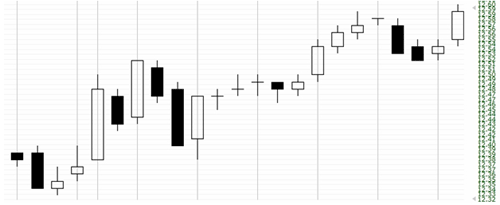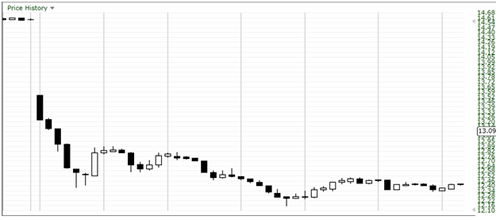The first part of this two-part series discussed our first simply day-trading rule: only initiate a long position when the current bar rises above the previous bar. Keep in mind that this is a trading trigger – it is independent of our bias as to whether the stock is expected to go up or down. This is a focused and narrow time-frame rule to be used on a 5 minute chart. But what is our second basic entry rule when shorting a stock? It is the exact opposite of our previous rule.
Basic Short Entry Rule #2: Only enter a short position when the bar you want to trade goes lower than the previous bar. Look at the previous two charts to see all the wonderful entries you could have had by following this one simple rule. There are 6 to 7 profitable entries on each chart even if this was the only rule you used to enter trades. Of course, you need to know when to get out of a position – or when to exit - and that will be discussed in a later article.
The chart below is Ford and each candle represent 5 minutes of trading. For this exercise we do not yet have a long or short bias. It can trade in either direction. As soon as the bar goes above the high of the previous bar – pretend that you bought or entered into a long position. If the bar dips below the lowest point of the previous candle – imagine you enter a short position. You are concentrating on two bars at a time when deciding to use this trigger or not. In this example you will only hold for the duration of that one bar (or you exit at the top of the solid part or the white bar or the bottom of the candle body of the black bar – but not the wicks since these are not closing prices).

How many trades could you have broke-even or made money on by following that rule? You should have about 12 or so trades where you could have made money and about three or four where you did not. This one simple rule puts the statistical odds in your favor of being profitable. For instance, imagine you were trading Ford with 1,000 shares and your goal was to take two pennies profit with a stop-loss at two pennies. You should have grossed a profit of $140 (figures may vary somewhat).
Again, don’t walk up to a stock and blindly trade the moment prices go above or below the previous bar. Consider this to be a ‘junior trader’ trigger but we still do not know whether we are biased long or short and we do not have an actual setup (or trading pattern).
Earnings can be a particularly exciting time to trade as prices become volatile and quick moving. Avis Budget Group reported earnings and it wasn’t well received. The chart below uses candles of 2 minutes each. Of course the most profitable move would be to short the stock during its morning drop, but for this example we will assume that we had a bias to buy. In general you should follow the trend, but the key here is to illustrate how these two rules will add a layer of protection even if you make the mistake of buying a falling stock (which should be avoided until you are proficient at trend-trading).

The chart below is merely a closeup of the first 14 bars of the above Avis chart. Notice how the stock falls and keeps bouncing lower. Let’s focus on the early part of the morning with our mistaken buying bias.

When is the first opportunity you would have to buy? Prices are as high as $13.54 and over the next 10 minutes they drop down to a low of $12.37. If you were trading 100 shares this would be a loss of $117. The first opportunity you have to buy is with the first white bar as it goes above the high of the previous bar. You would buy at $12.56 and the bar went as high as $12.87 or $31 profit on 100 shares.
As a new trader, you should only buy when a new high is formed and only short when a new low is formed when comparing it to the previous bar. This is true regardless of what time frame you are trading. Never try to guess ‘how low is low enough’ and buy when prices are falling making new lows. Looking back, the majority of bad entries came when I felt prices had fallen far enough coupled the compounding stupidity of averaging down – which is buying more and more shares while prices dropped. The adage is true that ‘the market can stay irrational longer than you can stay liquid’. ‘Never try to catch a falling knife’.
*Tip: The only time you should ignore this rule is if you show up late to the party. If one bar spikes from $10 to $11 you should not wait for the following bar to go above $11 to buy. The trade got away from you and the risk is now too high. It is better to avoid this two-bar rule when the first bar is extremely long.
This completes the two-part article series on simple trading triggers. To become a well-rounded trader you should first have a bias as to whether the stock is expected to rise or fall, and have exit strategies. You can read more on this in other articles at this site.